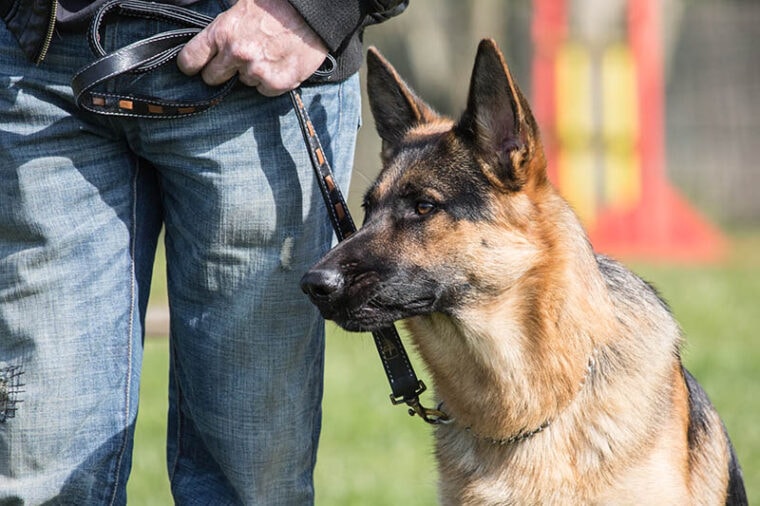
Dogs are known for their acute sense of smell, which humans use for many jobs. One of these is sniffing out cadavers, or dead bodies. These dogs are trained to locate human remains to help law enforcement, whether it’s to close a case, give closure to a family, or catch a dangerous criminal.
The Power of the Canine Nose
Humans have relied on the power of the canine nose for centuries. We’ve used dogs to track fugitives, find missing people, sniff out drugs or bombs, and more.
This is all because of the dog’s acute sense of smell. Humans have about six million scent receptors, but a dog has 200 to 300 million scent receptors 1. And the scent regions of their brains are about 40 times larger than that of a human.

The Development of Cadaver Dogs
Despite their incredible sense of smell, using cadaver dogs has only been around for a few decades. In the 1970s, during the Vietnam War, Army researchers considered the jobs that dogs could perform. New York State Trooper Ralph Suffolk Jr., a Bloodhound handler, was working with the Military Animal Science program at San Antonio’s Southwest Research Institute to test how well dogs could use their sense of smell for our purposes.
Suffolk trained a yellow Labrador Retriever as the first “body dog,” which is now known as a “cadaver dog2.”
From there, Andrew Rebmann, a co-author of the Cadaver Dog Handbook3, developed training programs for cadaver dogs. Though he wasn’t involved in the K9 handler program, he became involved in the training of cadaver dogs in the 1970s.
Using cadaverine and putrescine, two chemicals produced by decomposing corpses, Rebmann trained his first cadaver dog, Rufus, to seek out the scent of death. These chemicals are still used to train body dogs to find corpses. Rufus’s first major find was the body of a murdered woman buried four feet, covered in lime, and entombed under a concrete patio. So can cadaver dogs smell through concrete? Yes, absolutely!
Since then, the use of cadaver dogs has been important in missing person cases, homicide cases, and disaster recovery. Though law enforcement has more tools at its disposal now, a dog is a crucial complement to these methods.
How Accurate Are Cadaver Dogs?
Studies have found that cadaver dogs are 95% accurate at their work. They can even smell remains up to 15 feet underground and nearly 100 feet underwater. Sometimes, all they need is a drop of blood or a sliver of bone.
Cadaver dogs are also able to detect the difference between human and animal remains in their designated area, which can span 0.5 square miles. They can not only smell strong scents, but they can ignore the scent of diseased or decomposing animals while homing in on the specific scent of a deceased human.
Better yet, a cadaver dog can detect residue scent, or the smell left lingering after a body or body part was left somewhere. This is helpful in homicide investigations since a murderer may move a body.

How Are Cadaver Dogs Trained?
Cadaver dogs need about 1,000 hours of training before they’re capable of field work. This is more training than many jobs performed by humans.
Humans have unique smells while alive due to the unique bacteria on each of our bodies. But in death, all humans smell the same (more or less). We also have a unique scent that differs significantly from deceased animals other than a pig.
So how do cadaver dogs work? Cadaver dogs are taught to smell death at different stages of decomposition and for different species. Trainers use a variety of tools to train cadaver dogs, including:
Cadaver Dogs vs Detection Dogs
Though often included under the same umbrella, a detection dog is different from a cadaver dog. These dogs are used to detect specific substances, such as explosives, illicit drugs, currency, blood, wildlife remains or scat, and other contraband like illegal electronics.
There may be some overlap, but hunting dogs that seek out game, search dogs that look for missing people (alive and dead), and specific cadaver dogs are not generally considered detection dogs.
Along with law enforcement, detection dogs may be helpful for wildlife biologists and conservation scientists to find invasive species or collect samples from critical species. In the medical industry, detection dogs may be used to detect odors associated with medical conditions like cancer in living humans.
Final Thoughts
Cadaver dogs are an important asset for law enforcement to aid in investigations and recovery. These dogs are dedicated professionals who spend nearly two years undergoing intense training to become effective in the field. Though they’re providing a vital service to humanity, to the dog, it’s another job that happens to be a lot of fun!
Featured Image Credit: Metz Eric, Shutterstock








